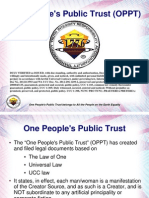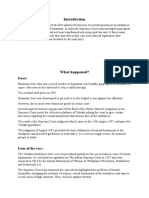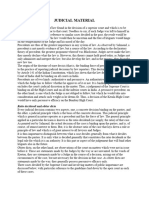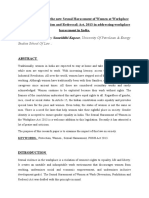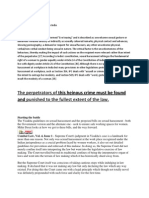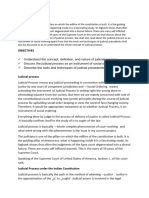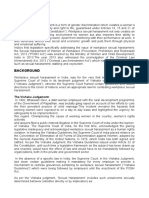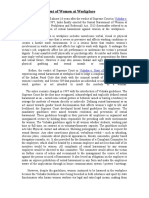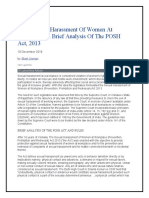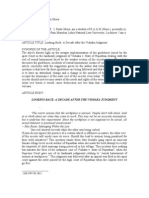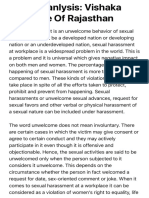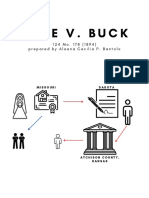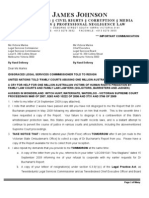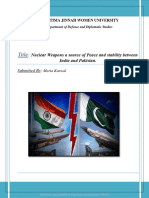0 ratings0% found this document useful (0 votes)
64 viewsSexual Harrassment at Workplace
Sexual Harrassment at Workplace
Uploaded by
riv's aquariumThis document provides an analysis of the Sexual Harassment of Women at Workplace Act, 2013 in India. It summarizes the key issues, including that sexual harassment creates an environment that hinders women's professional growth. The Vishaka Guidelines established by the Supreme Court in 1997 addressed this issue until the Act was passed in 2013, 16 years later. The Act aims to prevent and protect women from sexual harassment at work and provide redress for related complaints. It defines sexual harassment and workplaces and establishes complaint committees to address violations.
Copyright:
© All Rights Reserved
Available Formats
Download as ODT, PDF, TXT or read online from Scribd
Sexual Harrassment at Workplace
Sexual Harrassment at Workplace
Uploaded by
riv's aquarium0 ratings0% found this document useful (0 votes)
64 views22 pagesThis document provides an analysis of the Sexual Harassment of Women at Workplace Act, 2013 in India. It summarizes the key issues, including that sexual harassment creates an environment that hinders women's professional growth. The Vishaka Guidelines established by the Supreme Court in 1997 addressed this issue until the Act was passed in 2013, 16 years later. The Act aims to prevent and protect women from sexual harassment at work and provide redress for related complaints. It defines sexual harassment and workplaces and establishes complaint committees to address violations.
Copyright
© © All Rights Reserved
Available Formats
ODT, PDF, TXT or read online from Scribd
Share this document
Did you find this document useful?
Is this content inappropriate?
This document provides an analysis of the Sexual Harassment of Women at Workplace Act, 2013 in India. It summarizes the key issues, including that sexual harassment creates an environment that hinders women's professional growth. The Vishaka Guidelines established by the Supreme Court in 1997 addressed this issue until the Act was passed in 2013, 16 years later. The Act aims to prevent and protect women from sexual harassment at work and provide redress for related complaints. It defines sexual harassment and workplaces and establishes complaint committees to address violations.
Copyright:
© All Rights Reserved
Available Formats
Download as ODT, PDF, TXT or read online from Scribd
Download as odt, pdf, or txt
0 ratings0% found this document useful (0 votes)
64 views22 pagesSexual Harrassment at Workplace
Sexual Harrassment at Workplace
Uploaded by
riv's aquariumThis document provides an analysis of the Sexual Harassment of Women at Workplace Act, 2013 in India. It summarizes the key issues, including that sexual harassment creates an environment that hinders women's professional growth. The Vishaka Guidelines established by the Supreme Court in 1997 addressed this issue until the Act was passed in 2013, 16 years later. The Act aims to prevent and protect women from sexual harassment at work and provide redress for related complaints. It defines sexual harassment and workplaces and establishes complaint committees to address violations.
Copyright:
© All Rights Reserved
Available Formats
Download as ODT, PDF, TXT or read online from Scribd
Download as odt, pdf, or txt
You are on page 1of 22
Sexual Harassment of Women at Workplace: A Primer
on the Law
Prachi Dutta provides an analysis of the Sexual
Harassment of Women at Workplace Act, 2013.
Prachi Dutta
INTRODUCTION
Sexual Harassment is an insidious problem that poses
a serious impediment to society. Particularly, sexual
harassment of women at their place of work is a deep-
rooted problem which has severe negative
repercussions on the productivity, performance,
longevity of women in their careers and jobs. It can
hinder the professional growth of women as it creates
an environment which is not conducive for women to
thrive and evolve in. The problem of sexual
harassment of women at the workplace has been
recognised by Courts and governments, in most
countries across the world, and steps have been taken
to ensure that there are adequate safeguards to
protect women.
SEXUAL HARASSMENT OF WOMEN AT THE WORKPLACE
AND THE LAW IN INDIA
In India, the problem has been attempted to be
addressed by enacting the Sexual Harassment of
Women at Workplace Act (Prevention, Prohibition. and
Redressal) Act, 2013 (“The Act”), colloquially known as
the “POSH Act”. The Act is to prevent and protect
women against sexual harassment at workplace and
provide a redressal mechanism to address complaints
of sexual harassment or connected or incidental
matters.
The Act is a product of the “Vishaka Guidelines” that
were formulated by the Hon’ble Supreme Court of
India (“The Supreme Court”) in the case of Vishaka vs
State of Rajasthan 1 (“Vishaka Case”). This case is
monumental as it started a dialogue about the
problems and perils that women face during the course
of their employment or while trying to carry out their
professional duties and steps that can be taken to
rectify this problem. The Vishaka Case was brought in
as a class action by certain NGOs to focus the
attention towards preventing sexual harassment of
working women in all workplaces through judicial
process. In this case, a social worker, as part of her
professional duties, attempted to stop a child marriage
from taking place and was gangraped by members of a
community as they viewed her intervention as an
“assault” on their customs and traditions. The
Supreme Court realised that the incident reveals the
hazards to which working women may be exposed to
and the depravity to which sexual harassment can
degenerate and the urgency for safeguards by an
alternate mechanism in the absence of the legislative
measures and took the view that such incidents of
sexual harassment are a violation of the fundamental
rights under Article 14 2, 15 3, 21 4 of the Constitution
of India and consequently a violation of the victim’s
fundamental right under Article 19(1)(g) 5. The
Supreme Court also focused on the contents of
international conventions and norms such as the
Convention on the Elimination of All Forms of
Discrimination against Women and the Beijing
Statement of Principles on the Independence of the
Judiciary in the LAWSIA region, for the purpose of
interpreting the aforementioned fundamental rights as
the international conventions enlarge the meaning and
content of these provisions and promote the object of
the constitutional guarantee. Thereafter, the Supreme
Court, under their power under Article 32 and
consequentially Article 141 of the Constitution,
guidelines and norms were laid down which were to be
followed and observed at all workplaces or other
institutions until a legislation was enacted for the same
purpose. The guidelines defined sexual harassment,
mentioned preventive steps to be taken, stated the
procedure of adopting a complaint mechanism and
committee, amongst other crucial steps to be followed.
1. (1997)6 SCC 241
2. Equality before law: The State shall not deny any
person equality before the law or the equal protection
of the laws within the territory of India
3. Prohibition of discrimination on grounds of religion,
race, caste, sex or place of birth
4. Protection of life and personal liberty: No person
shall be deprived of his life or personal liberty expect
according to procedure established by law
5. Protection of certain rights regarding freedom of
speech, etc.: All citizens shall have the right to
practise any profession, or to carry on any occupation,
trade or business
However, the guidelines were not promptly
implemented and a legislation was enacted at an
extremely belated stage and consequently the
Supreme Court observed in the case of Medha Kotwal
Lele v Union of India 6 that the directions are not
supposed to be symbolic but must be followed. The
Supreme Court directed States and Union Territories to
carry out amendments in their respective Civil Services
Conduct Rules, carry out amendments in the Industrial
Employment (Standing Orders) Rules, form adequate
number of Complaints Committees so as to ensure that
they function at taluka level, district level and state
level. Further, organisations such as The Bar Council of
India shall ensure that all bar associations in the
country and persons registered with the State Bar
Councils follow the Vishaka guidelines and Medical
Council of India, Council of Architecture, Institute of
Chartered Accountants, Institute of Company
Secretaries and other statutory Institutes shall ensure
that the organisations, bodies, associations,
institutions and persons registered/affiliated with them
follow the guidelines laid down by Vishaka. Thereafter,
in the Seema Lepcha vs State of Sikkim 7, the
Supreme Court directed all States and Union
Territories to publicise and broadcast the compliances
and committees that they have formed. Further, the
enactment of the Act was thoroughly belated and
prolonged as it was enacted 16 years after the
guidelines were formulated by the Supreme Court. The
Act was also introduced in the Lok Sabha 10 (ten)
years (in 2007) after the guidelines were formulated
and was ultimately passed by the Rajya Sabha, after
an amendment was introduced in 2012, only on
26.02.2013 and it was eventually enacted and in force
on 22.05.2013.
It is pertinent to note that there also exists a penal
provision for sexual harassment under the Indian
Penal Code, 1860 (“IPC”). Section 345A contains the
provisions of what constitutes as “sexual harassment”
and the punishment for it as well. However, it is
pertinent to note that this provision is not only
restricted to those acts of harassment committed in
the workplace and by invoking this provision for a case
of sexual harassment at the workplace, it would take
the form of a regular criminal complaint and the rules
and provisions of the Act would not be applicable.
However, a person can invoke Section 345A IPC and
also file a complaint under the Act as both the
remedies can co-exist in a parallel manner.
SALIENT FEATURES OF THE ACT
It is pertinent to note that the Act is a work in
progress as its provisions are constantly being
interpreted in order to give them a broad and liberal
meaning, so that the actual spirit and intent of the Act
is being fulfilled. Therefore, several definitions in the
Act and in the guidelines are not solely restricted to
the description given in the Act or the guidelines and
their interpretation is constantly evolving and
expanding.
6. (2013) 1 SCC 297
7. (2013) 11 SCC 641
What constitutes as sexual harassment
The Act states certain behaviour, act or
8
circumstances that may amount to sexual
harassment. However, sexual harassment is not only
restricted to such behaviour and through various case
laws, the Courts have enlarged the definition of sexual
harassment to give a broad and liberal interpretation
to behaviour or acts that constitute as sexual
harassment. In the case of Apparel Export Promotion
Council vs AK Chopra 9, the Supreme Court held that
sexual harassment is not just restricted to physical
contact but is a form of sex discrimination projected
through unwelcome sexual advances, request for
sexual favours and other verbal or physical conduct
with sexual overtones, whether directly or by
implication, particularly when submission to or
rejection of such a conduct by the female employee
was capable of being used for effecting the
employment of the female employee. Further, in the
case of Shanta Kumar vs Council of Scientific and
Industrial Research & Ors 10, the Delhi High Court held
that even though physical contact or advances would
constitute sexual harassment, such physical contact
must be a part of the sexually determined behaviour
and be in the context of a behaviour which is sexually
oriented. Plainly, a mere accidental physical contact,
even though unwelcome, would not amount to sexual
harassment. Similarly, a physical contact which has no
undertone of a sexual nature and is not occasioned by
the gender of the complainant may not necessarily
amount to sexual harassment. Therefore, the definition
of sexual harassment and what it constitutes is a grey
and nebulous area, which is not static either; the
definition and ambit is being constantly evolved and
enhanced, in order to ensure that the actual spirit and
intent of the Act is being fulfilled.
What constitutes as a “workplace”
Another important definition is that of
11
“workplace” which is not restricted solely to that
mentioned in the provision and has been interpreted
by Courts in order to ascribe a broader meaning to it.
In the case of Saurabh Kumar Mallick v Comptroller
and Auditor General of India and Anr 12, the Delhi High
Court stated that a narrow and pedantic approach
cannot be taken in defining the term ‘work place’ by
confining the meaning to the commonly understood
expression “office” that is a place where any person of
the public could have access. Therefore, each incident
of sexual harassment at the work place has to be
considered in the facts and circumstances of that
particular case and the definition of workplace cannot
be generalized to include all residences within the
meaning and ambit of work place, at it may lead to
absurdity. Further, the test laid down to determine a
particular place is work place or not (by the Tribunal in
this case), is the proximity from the place of work,
control of management over such place/residence
where working woman is residing; and such a
‘residence’ has to be an extension or contiguous part
of working place. At the same time, for proceeding
against an employee in a departmental inquiry, a
sweeping definition of ‘work place’ is not necessary
where it is interpreted to include the conduct of an
employee which would have no relation to work and
private disputes are not to be included.
That one of the most crucial aspects of the act is the
constitution of an Internal Complaints Committee
(“ICC”) and consequently the guidelines for their
functioning. The Act also provides for the constitution
of a Local Complaints Committee which is a significant
aspect of the Act. A Local Complaints Committee 13 is
one that is to be set up in every district to receive
complaints of sexual harassment from establishments
where the Internal Complaints Committee has not
been set up or the complaint is against the employer.
This provision of a Local Complaints Committee is
extremely crucial as it provides a redressal mechanism
to victims of sexual harassment in the absence of a
redressal mechanism, i.e. the Internal Complaints
Committee in their place of employment. This
provision gives a redressal mechanism to those victims
who are engaged in the “unorganised” sector such as
agricultural workers, labourers, domestic workers, etc.
A detailed analysis of the ICC and its mechanism is
given subsequently in this article.
8. Section 3 of the Act
9. (1997) 77 FLR 918 (Del)
10. (2018) 2 CLR 71
11. Section 2(o) of the Act
12. (2008) 151 DLT 261 (DB)
13. Section 5,6 of the Act
Statute of Limitation
It is pertinent to note that there does exist a period of
limitation in filing a complaint. A victim can file a
complaint only within a period of three months from
the date of the last incident 14. However, this period of
three months can be extended to an additional period
of three months if the Committee is satisfied that the
circumstances were such that they prevented the
victim to file the complaint 15 and the same was held
by the Delhi High Court in the case of Tejinder Kaur v
Union of India 16. Therefore, only in extraneous
circumstances when a victim could not file a complaint
within three months, would the maximum time limit of
filing a complaint be that of 6 (six) months, albeit the
discretion to extend the time limit lies with the
Committee and the Committee can dismiss the
extension request.
Conciliation and Inquiry
The Act also envisages that the Committees should
attempt conciliatory methods to settle the matter
between the concerned parties before proceeding with
conducting an inquiry or investigation however no
monetary settlement can be made as a basis to the
conciliation 17. Thereafter, in the event that the
conciliatory proceedings fail, the Committee is to
conduct an inquiry 18. After this, an inquiry report is to
be submitted to either the District Officer or the
employer, depending on the Committee, within 10
tends of inquiry, with either the fact that the
allegations have not been proved or recommendations
in the event that the allegations against the
Respondent have been proved and the same has to be
acted upon within a period of 60 (sixty) days from the
date of receipt of the report 19.
The Act also safeguards those who are a victim of false
or malicious complaints by directing a punishment in
accordance with the service rules applicable to the
person or in a manner as may be prescribed 20 and the
recommendation will be made only after an inquiry is
carried out. In the event that employers do not comply
with the provisions of the Act, a fine which may extend
to Rs.50,000/- shall be imposed on them 21.
14. Section 9 (1)
15. Proviso to Section 9(1)
16. (2018) 1 CLR 660
17. Section 10 of the Act
18. Section 11 of the Act
19. Section 13 of the Act
20. Section 14 of the Act
21. Section 26 of the Act
WORKING AND MECHANISM OF THE INTERNAL
COMPLAINTS COMMITTEE
Importance of a sound ICC
The ICC is the bedrock of this Act and the smooth and
proper functioning of ICCs is extremely crucial to
ensure that the intent and spirt of the Act is fulfilled. It
is also important for the ICC to be constituted exactly
in accordance with the Act as an improperly
constituted and infirm ICC leads to their
recommendations or decisions being vitiated and set
aside by Courts. Further, a procedurally sound and fair
or just composition of the ICC will attempt to ensure
that a fair inquiry investigation is conducted, a proper
and just recommendation or report is arrived and
both, the victim and the Respondent, get the justice
they deserve.
Further, a properly constituted ICC ensures that a
tangible outcome is arrived at, and this is especially
important in present day, as newer mediums of voicing
one’s “grievances” and alleged “redressal” are
emerging such as narrating one’s grievances on social
media. This itself poses several problems, namely lack
of accountability on part of the victim and lack of
impact or retribution on the “perpetrator” and more
often than not, does not bring any justice to the party
who has been wronged. In order to curb this
problem,ICCs must be constituted and strengthened in
order to provide a proper and adequate redressal
mechanism to victims of sexual harassment or to those
who have been falsely accused of it.
Composition of an ICC
The ICC has to have a presiding officer who shall be a
woman employed at a senior level or in the absence of
a senior level employee, one who is from other offices
or units of the workplace or in the absence of this as
well, a senior level woman employee from any other
workplace of the same employer or organisation or
department 22. It is pertinent to mention that there is
nothing to the contrary to indicate that the “lady
member” is to be senior in rank to the officer against
whom the allegation of sexual harassment are brought
and the same was held by the Allahabad High Court in
the case of Shobha Goswami v State of Rajasthan 23.
Further, there have to be two other members in the
ICC who are employees who are preferably either
committed to the cause of women or who have
experience in social work or legal knowledge 24.
Further, one member of the ICC has to be a person
from an NGO or associations committed to the cause
of women or who is familiar with issues of sexual
harassment 25. This provision of an “external member”
is important and an ICC must adhere to appointing an
external member in consonance with this provision as
the report or the ICC can be vitiated and invalid if the
appointment and qualification of the external member
is not in conformity with the requisite provision. The
Bombay High Court held in the case of Jaya Kodate v.
Rashtrasant Tukdoji Maharaj Nagpur University,
Bombay High Court 26 that the ICC without the
presence of an external member (either dedicated to
the cause of women or having experience in social
work or have legal knowledge related to sexual
harassment) would be illegal and contrary to the
provisions of the Act. Further, In the case of Ruchika
Singh Chhabra v M/S Air France India & Ors. 27, the
Delhi High Court invalidated the report of the ICC and
set it asideas the external member was not associated
with a non-governmental organization and his
qualifications have not been informed to the
complainant.
22. Section 4(2)(a) of the Act
23. 2015 LLR 1038
24. Section 4(2)(b) of the Act
25. Section 4(2)(c ) of the Act
26. [2014 SCC OnLine Bom 814]
27. 2018 LLR 697
Further, the Court stated that the external member is
not protected under Rule 4 of the Sexual Harassment
of Women at Workplace (Prevention, Prohibition and
Redressal) Rule, 2013 (“Rules 2013”)as they only
apply District Committee under Section 7 because the
constitution of district committees already includes
independent members and not to ICCs. Further, all
ICCs have to have atleast one-half (50%) of their
members as women. The tenure of all the members of
the ICC is three years and any vacancy should be filled
expeditiously. Also, a proper ICC is that it cannot have
less than 3 (three) members and if there are less than
three members, then the recommendation of the ICC
is liable to be vitiated.
Composition of a Local Complaints Committee
The Local Complaints Committee is to have a
composition in which the Chairperson must be a
woman who is an eminent in the field of social work
and committed to the cause of women, one woman
member who is a woman working in the block, taluka,
tehsil or ward or municipality in the district 28. Further,
two other members must be nominated out of which
atleast one is from an NGO or association committed
towards cause of women or person familiar with issues
of sexual harassment 29. Further, out of these
nominees, atleast one must have a background in law
or legal knowledge and atleast one shall belong to
Scheduled Castes or Scheduled Tribes of Other
Backward Classes or minority communities as
notified 30. The tenure of the members is three
years 31.
It is also pertinent and crucial to note that the
proceedings of the ICC shall not be published,
communicated or made known to the public, press and
media 32 and in the event that this is contravened, the
person who does so shall be liable for penalty in
accordance with the service rules or in the absence of
such, in any manner as may be prescribed 33.
ICC and the Principles of Natural Justice
During the inquiry process, an ICC or Local Complaints
Committee is vested with the same powers as that of a
civil court under the Code of Civil Procedure, 1908 in
terms of summoning and enforcing attendance of any
person and examine him under oath, discovery and
production of documents or in any other manner as
may be prescribed 34. The inquiry process has to be
completed within a period of 90 (ninety) days, as the
provision for this in the Act is a mandatory
provision 35. The inquiry process must be in accordance
to the service rules applicable or in any other manner
as may be prescribed. Further, the enquiry conducted
by the ICC should be a full-fledged inquiry complying
with the principles of natural justice, as stated in the
case of M/S Air India Represented By Its Chairman and
Managing Director and Others v L.S. Sibu and
Others 36 and also under Rule 7(4) of the Rules 2013.
Further, in enquiry proceedings, strict rules of
evidence are not required to be followed and the
enquiry committee can adopt its own procedure in
conformity with the principles of natural justice, as
held by the Delhi High Court in the case of Gaurav Jain
vs Hindustan Latex Family Planning Promotion Trust &
Ors 37. The principles of natural justice and rules in
conformity with thus would include a sufficient and
reasonable opportunity given to Respondent (accused)
to respond to the allegations made against him 38,
amongst other various principles of natural justice.
28. Section 7 (1) (a) and (b) of the Act
29. Section 7 (1)( c) of the Act
30. Ibid
31. Section 7(1)(2) of the Act
32. Section 16 of the Act
33. Section 17 of the Act
34. Section 11 (3) of the Act
35. Section 11(4) of the Act
36. 2018 SCC OnLine Ker 13878
37. 2015 SCC OnLine Del 11026
38. Ibid
Often decisions or recommendations of an ICC is
challenged in a Court on the grounds of bias in the
proceedings or in the composition of the Committee.
This problem and issue of bias in the ICC inquiry and
report has been adequately addressed by various
courts. In the case of Somaya Gupta v Jawaharlal
Nehru University and Anr. 39, the Delhi High Court held
that a real likelihood of bias must be established and a
mere apprehension in the Petitioner's (victim) mind
would be insufficient for securing such relief. Further,
since there was no allegation that any of the members
of the ICC have any pecuniary or personal interest in
the matter and no material on record which would
even remotely lead to any suspicion that the members
of the ICC have any personal interest that would
conflict in their obligation to conduct an inquiry fairly
and make a fair recommendation, is insufficient to
doubt the integrity or ability of the ICC to render an
unbiased opinion 40. In the case of U.S. Verma,
Principal, DPS & Anr. vs. National Commission for
Women & Ors, 41 the Delhi High Court held that an
elementary principle of natural justice is that the
administrative authority should be free from bias. Bias
or impartiality is fairly easy to comprehend however
there frequently are situations when the dividing line
between what is acceptable, and what is not, is not a
bright one. On such occasions, Courts have chosen to
follow the “reasonable likelihood” of bias standard,
which has now been reiterated as a “strong suspicion”
of bias standard and this, coupled with the sound
aphorism that not only impartiality, but the
appearance of impartiality, should be the guiding
standard, is the criterion which Courts ordinarily
follow 42. In the case of Vidya Akhave v Union of India
& Ors. 43, the Bombay High Court held that the Court
will be slow in interfering with the punishment
imposed by the Disciplinary Authority if the Court does
not conclude that the penalty imposed is shockingly
disproportionate to the misconduct committed by the
employee. Therefore, allegations of bias and
unfairness and absence of adherence of the principles
of natural justice have to be reasonable, strong, likely
and have to be adequately established by the person
alleging it in order to a Court to vitiate the proceedings
of the ICC on grounds of bias.
INTERNAL COMPLAINTS COMMITTEE AND
EDUCATIONAL INSTITUTIONS
Educational institutions, such as school, colleges,
universities also come under the purview of the Act
and therefore are obligated to set up an ICC in their
respective institutions. In schools, all employees,
teachers and non-teaching staff, are covered under the
provisions of the Act since schoolsare within the
definition of “workplace”. It is however pertinent to
note that in schools, the Act only covers the
employees and not the students, since the students
are under the age of 18 years old and therefore any
instance of sexual harassment or violation will attract
the provisions of the Protection of Children From
Sexual Offences Act,2009.
39. (2018) 159 FLR 390
40. Ibid
41. (2009) 163 DLT 557
42. Ibid
43. (2016) 6 AIR Bom R 506
The Government of NCT Of Delhi vide notification
number “NO.F.DE.15/Act-
I/VishakhaGuidelines/2014/25342-47”, dated
28.07.2014, directed all schools to observe guidelines
to protect women from sexual harassment at
workplace and directed all schools, including private
unaided registered school to form an ICC to serve as a
redressal mechanism. Not withstanding these
regulations and guidelines, in the event that a school,
day care centre, nursery or creche does not have a
duly constituted ICC, then the aggrieved woman can
file a complaint with the Local Complaints Committee.
Universities and colleges too fall under the purview of
the Act. The University Grants Commission (“UGC”),
vide letter dated 14.05.2019, bearing number DO. Ni.
F. 91-3/2014(GS)Pt. 1, addressed to the Vice-
Chancellors of all Universities, directing them to
ensure that an ICC and Special Cell is constituted in
their institutions to deal with issues of gender based
violence. Further, the UGC has formulated the
University Grants Commission (Prevention, Prohibition
and Redressal of Sexual Harassment of Women
Employees and Students in High Educational
Institutions) Regulations, 2015 which applies to all
higher educational institutions in India. Under these
regulations, the provisions of the Act are extended to
higher educational institutions and campuses in India.
These regulations direct that an ICC be set up in all
universities and direct that the composition of the ICC
differ in the event that the matter involves students 44.
Further, the regulations explicitly forbade senior
administrative post holders such as the vice-
chancellor, pro-vice Chancellor, Deans, Registrar, etc.
from being members of the ICC 45. The process of
inquiry of the ICC is similar to that in the Act.
However, the punishment is slightly different and
differs when the offender is an employee or a
student 46. These regulations are important as they
ensure that the provisions of the Act are being
implemented and that students and employees in
higher educational institutions have an adequate
redressal mechanism.
APPELLATE REDRESSAL MECHANISM
Any person who is aggrieved by the recommendations
made by the ICC and the Local Complaints Committee,
may prefer an appeal to the Court or tribunal in
accordance with the provisions of the service rules or
in the absence of service rules, any such manner as
may be prescribed, within a period of ninety days since
the recommendations 47. Further, under the Rules
2013, a person may prefer an appeal to the appellate
authority notified under Section 2(a) of the Industrial
Employment (Standing Orders) Act, 1946 48. However,
the problem arises when the appellate authority has
not been set up, particularly given the fact that Courts
do not function as an appellate authority of ICC
decisions. The absence of an appellate authority is
detrimental and negates the very purpose of the Act
as an aggrieved person is denied an appellate
redressal forum in the face of an infirm and
disproportionate verdict. It is crucial that a strong
appellate authority is set up in, especially in the
absence of service rules, so that an aggrieved person
has the option and legal remedy to approach an
appellate authority, in order to rectify any infirmity in
the recommendation of the ICC, so that the purpose
and spirit of the Act are intact and fulfilled.
44. Section 4(1)(c) of the Act
45. Section 4(3) of the Act
46. Section 10(1) and 10(2) of the Act
47. Section 18(1) and Section 18(2) of the Act
48. Rule 11 of the Rules 2013
SEXUAL HARASSMENT ELECTRONIC BOX (SHE-BOX)
The concept of Sexual Harassment Electronic Box or
“She-Box” has been developed by the Government of
India. It is an online platform which is available on the
website of the Ministry of Women and Child
Development. The She-Box was developed to ensure
that the Act is effectively implemented. It provides a
compliant redressal mechanism to all woman working
either in the organised or unorganised, private or
public sector and who have faced instances of sexual
harassment at their respective workplace 49. Any
woman facing sexual harassment at workplace can
register their complaint through this portal and the
complaint is thereafter directly sent to the concerned
authority having jurisdiction to take action into the
matter, such as the ICC of the organisation 50. This is
an important development as it provides an accessible
redressal mechanism to women who are victims of
sexual harassment at their workplace.
CONCLUSION
The enactment of the Act, albeit thoroughly belated,
has been a crucial step towards combating the menace
of sexual harassment at the workplace. The Act
provides for a redressal mechanism in order to ensure
a fair inquiry and consequentially a just and
reasonable recommendation, so that the aggrieved
person gets the justice they deserve. The Act is a work
in progress and its provisions are constantly being
interpreted in a liberal manner by Courts, in order to
broaden the purview and ambit of these provisions, so
that the true intent of the Act is fulfilled.All workplaces
must adhere to the provisions of the Act and ensure
that the spirit of the Act is fulfilled. In order to ensure
this is done, the penalty of non-compliance should be
enhanced to serve as a reasonable deterrence to
employers who do not comply with the Act, especially
in setting up a procedurally sound and fair ICC. It
should also be clarified as to who the fine is paid to, as
the Act is silent on it. Further, employees should
ensure that an inquiry is carried out as expeditiously
as possible and definitely within the period of 90 days,
in order to prevent prolonged mental agony to both
the parties.
Further, the Act is one that is intended to address and
the rectify the problem of sexual harassment at the
workplace faced by women and some lacunae in the
Act are still prevalent. For example, the Act can also
be misused, in the form of a false, vengeful and
frivolous complaint filed by a person. In order to
ensure that the Act is not misused and abused and
that its true intent is intact, the provision regarding
penalty and punishment for false or malicious
complaint (Section 14 of the Ac) must be clarified and
employers should lay down in detail the penalty and
punishment for filing false complaints in the absence
of any service rules. Further, the limitation period of
filing a complaint of 3 months should be enhanced to a
significantly larger time period, as such incidents can
have serious and negative repercussions of the
mental, emotional, physical well-being of a person and
person may lack the courage, strength and mental
bandwidth to come forward to file a complaint within a
period as short as three months from the time when
the incident occurred.
49. http://www.shebox.nic.in/user/about_shebox
50. Ibid
The Act is intended to create a safe space for women
to thrive and work in and therefore all possible efforts
should be made by all stakeholders in ensuring that
the ideals and intent of the Act are upheld. Employees
should conduct workshops and seminars regularly to
acquaint employers with the provisions of the Act and
sensitise them about gender and sexuality, in order to
create awareness about the problems and perils of
sexual harassment. Further, in a broader sense,
conversations and dialogues should take place,
starting from in schools, in order to create awareness
about gender and diversity and consequential to
reduce gender based discrimination and stereotypes
that are often developed at a young age. By doing
thus, the seeds of creating an environment where
women can be safe and can thrive and grow in are
sown at an early stage.
You might also like
- One People Public Trust - SlideDocument38 pagesOne People Public Trust - SlideHearthaware blog50% (2)
- Sexual Harrassment at WorkplaceDocument9 pagesSexual Harrassment at Workplaceriv's aquariumNo ratings yet
- IntroductionDocument8 pagesIntroductionNishant Singh DeoraNo ratings yet
- Vishakha Vs State of RajasthanDocument13 pagesVishakha Vs State of RajasthanAditya KaranNo ratings yet
- Judicial MaterialDocument11 pagesJudicial MaterialJulius CaesarNo ratings yet
- Critical Analysis On Sexual Harassment in Workplace inDocument15 pagesCritical Analysis On Sexual Harassment in Workplace inMeganathNo ratings yet
- This Article Is Written by Samriddhi Kapoor, University of Petroleum & Energy Studies School of LawDocument6 pagesThis Article Is Written by Samriddhi Kapoor, University of Petroleum & Energy Studies School of LawSamriddhi KapoorNo ratings yet
- Sexual HarassmentDocument20 pagesSexual HarassmentAman KumarNo ratings yet
- Vishaka and Others V. State of RajasthanDocument10 pagesVishaka and Others V. State of RajasthanPiyush Nikam MishraNo ratings yet
- Vishakha Vs State of Rajasthan RPDocument5 pagesVishakha Vs State of Rajasthan RPBhavi Ved0% (1)
- Vishaka v. State of RajashtanDocument7 pagesVishaka v. State of RajashtanAvinash Borana89% (18)
- History - Anti Sexual Harassment in IndiaDocument4 pagesHistory - Anti Sexual Harassment in IndiaaishwaryaNo ratings yet
- Posh Act - Implementational ChallengesDocument7 pagesPosh Act - Implementational ChallengesRiya PareekNo ratings yet
- Anushka Gupta Legal Assignment PDFDocument13 pagesAnushka Gupta Legal Assignment PDFANUSHKANo ratings yet
- Anushka Gupta Legal AssignmentDocument13 pagesAnushka Gupta Legal AssignmentANUSHKANo ratings yet
- Yash Jain Case3Document2 pagesYash Jain Case3YashJainNo ratings yet
- Precedence and LegislationDocument6 pagesPrecedence and Legislationmaryam2xiaNo ratings yet
- Case Summary Medha Kotwal Lele Vs Union of India October 2012Document3 pagesCase Summary Medha Kotwal Lele Vs Union of India October 2012Dr. Rakesh KumarNo ratings yet
- Protection of Women From Sexual Harassment Act, 2013: Why in News?Document3 pagesProtection of Women From Sexual Harassment Act, 2013: Why in News?Piyush SoniNo ratings yet
- Sexual Harassment of Women at Work PlaceDocument21 pagesSexual Harassment of Women at Work PlacehygfttgNo ratings yet
- SamriddhiDocument7 pagesSamriddhiSamriddhi KapoorNo ratings yet
- The Perpetrators of Punished To The Fullest Extent of The LawDocument6 pagesThe Perpetrators of Punished To The Fullest Extent of The LawCharit MudgilNo ratings yet
- VishakhaDocument14 pagesVishakhaaniket aryanNo ratings yet
- 32368legal22291 MDocument19 pages32368legal22291 MratiNo ratings yet
- Vishaka vs. State of RajasthanDocument12 pagesVishaka vs. State of RajasthanRIYA JAINNo ratings yet
- 1.1 Judicial Process As An Instrument of Social OrderingDocument6 pages1.1 Judicial Process As An Instrument of Social Orderingsuryanarayandas1994No ratings yet
- Vishaka CaseDocument3 pagesVishaka CaseVinod JoshiNo ratings yet
- Essay 6 - Sexual HarassmentDocument12 pagesEssay 6 - Sexual HarassmentAsha YadavNo ratings yet
- Efficacy of Laws Relating To Sexual Harassment of Women at Workplace in India: StudyDocument10 pagesEfficacy of Laws Relating To Sexual Harassment of Women at Workplace in India: StudyKaushiki SharmaNo ratings yet
- Sexual Harassment of Women at The WorkplaceDocument4 pagesSexual Harassment of Women at The WorkplaceABHISHEK ANANDNo ratings yet
- POSH Act JudgementsDocument8 pagesPOSH Act JudgementsDisha BasnetNo ratings yet
- Women and CriminalDocument5 pagesWomen and CriminalAdhiraj singhNo ratings yet
- VIshakha Guidelines & POSHDocument8 pagesVIshakha Guidelines & POSHManish KumarNo ratings yet
- Sexual Hazartment of Women at OfficeDocument3 pagesSexual Hazartment of Women at OfficeMohandas PeriyasamyNo ratings yet
- SBILL CHP 20Document24 pagesSBILL CHP 20Chayank lohchabNo ratings yet
- India:: Sexual Harassment of Women at Workplace: A Brief Analysis of The POSH Act, 2013Document4 pagesIndia:: Sexual Harassment of Women at Workplace: A Brief Analysis of The POSH Act, 2013Yash SinghNo ratings yet
- Moot 3Document3 pagesMoot 3rudraniNo ratings yet
- Sexual Harassment of Women at Workplace (Prevention, Prohibition and Redressal) Act, 2013 - WikipediaDocument37 pagesSexual Harassment of Women at Workplace (Prevention, Prohibition and Redressal) Act, 2013 - WikipediaJAHANGEER AHAM BAHTNo ratings yet
- VISHAKA v. STATE OF RAJASTHAN, AIR 1997 SC 3011Document15 pagesVISHAKA v. STATE OF RAJASTHAN, AIR 1997 SC 3011Shazaf Khan100% (1)
- Sexual Harassment The Unrecognized Gender 1705512433Document15 pagesSexual Harassment The Unrecognized Gender 1705512433HarshNo ratings yet
- Project On Harassment of Women at Work PlaceDocument22 pagesProject On Harassment of Women at Work PlaceAbhinav PrakashNo ratings yet
- Law Related To W&C 200013015023Document10 pagesLaw Related To W&C 200013015023khushi JainNo ratings yet
- Shakshi Vs Union of IndiaDocument12 pagesShakshi Vs Union of IndiaTanuj Shankar GaneshNo ratings yet
- Gdiom Case LawsDocument25 pagesGdiom Case Lawsyashjoshi297No ratings yet
- RESOURCE - 1 Employee IntroDocument3 pagesRESOURCE - 1 Employee IntrosnzrealtorsNo ratings yet
- Case StudyDocument14 pagesCase StudyAshish pariharNo ratings yet
- 16010125004-The Sexual Harassment of Women at WorkplaceDocument8 pages16010125004-The Sexual Harassment of Women at WorkplaceSudev SinghNo ratings yet
- Presentation Sexual Harassment at WorkplaceDocument21 pagesPresentation Sexual Harassment at WorkplaceRajiv RanjanNo ratings yet
- Sexual Harassment FootnotesDocument15 pagesSexual Harassment FootnotesPriyadarshan NairNo ratings yet
- Law and Social Transformation - A Study With Special Reference To IndiaDocument9 pagesLaw and Social Transformation - A Study With Special Reference To IndiaPayal PatadiyaNo ratings yet
- Vishakha and Others v. State of Rajasthan and Others: CA2.AssignmentDocument6 pagesVishakha and Others v. State of Rajasthan and Others: CA2.Assignmentmayank sachdeva100% (1)
- Vishaka JudgmentDocument11 pagesVishaka Judgmentrashi_misra100% (2)
- Law Relating To Sexual Harassment of Women at The Workplace in India: A Critical ReviewDocument23 pagesLaw Relating To Sexual Harassment of Women at The Workplace in India: A Critical ReviewAhmedNo ratings yet
- Sexual Harrasment at Workplace ActDocument17 pagesSexual Harrasment at Workplace ActLivanshu Garg67% (3)
- SocioprojDocument13 pagesSocioprojshatakshi152-22No ratings yet
- Case Ananlysis - Vishaka V - S. State of RajasthanDocument11 pagesCase Ananlysis - Vishaka V - S. State of Rajasthannitin kashyapNo ratings yet
- JPIOSDocument51 pagesJPIOSsastika agrawalNo ratings yet
- Consti ReportDocument6 pagesConsti ReportbuvaniyaasNo ratings yet
- AIBE 1100 - Que & AnsDocument228 pagesAIBE 1100 - Que & AnsSoma Sundaram NNo ratings yet
- Republic Act NoDocument5 pagesRepublic Act NoAlexis VinteroNo ratings yet
- Building Democracies in South AsiaDocument5 pagesBuilding Democracies in South AsiaPankajKumarNo ratings yet
- Ruhe v. Buck ReportDocument12 pagesRuhe v. Buck ReportAleana Cecilia BantoloNo ratings yet
- History of Modern JapanDocument4 pagesHistory of Modern Japanjagriti pandeyNo ratings yet
- Rejoinder - Sca 8150 of 2021Document6 pagesRejoinder - Sca 8150 of 2021loserambujNo ratings yet
- Revised WCP Application FormDocument1 pageRevised WCP Application FormPatbau100% (1)
- Workers Vanguard No 165 - 8 July 1977Document12 pagesWorkers Vanguard No 165 - 8 July 1977Workers VanguardNo ratings yet
- Email LeadsDocument83 pagesEmail LeadsdigitallyawakeNo ratings yet
- Guidelines To Bill of Rights Act PDFDocument501 pagesGuidelines To Bill of Rights Act PDFjosesalgadogNo ratings yet
- Letter To Legal Services Commissioner 20091006Document2 pagesLetter To Legal Services Commissioner 20091006James JohnsonNo ratings yet
- 1991 DBQ - Treaty of VersaillesDocument4 pages1991 DBQ - Treaty of VersaillesAndrew McGowanNo ratings yet
- MumbaiDocument3 pagesMumbaiRahul BoseNo ratings yet
- Appointment of Chairperson Member Judicial and Member Non Judicial in Telangana State Human Rights CommissionDocument6 pagesAppointment of Chairperson Member Judicial and Member Non Judicial in Telangana State Human Rights CommissionKRANTHI KIRAN PVNo ratings yet
- Bordentown City OPRA FormDocument2 pagesBordentown City OPRA FormThe Citizens CampaignNo ratings yet
- Tigno V Aquino DigestDocument4 pagesTigno V Aquino DigestMiamor NatividadNo ratings yet
- CorruptionDocument158 pagesCorruptionTaher TobaliaNo ratings yet
- Nuclear Weapons A Source of Peace and Stability Between India and PakistanDocument7 pagesNuclear Weapons A Source of Peace and Stability Between India and Pakistanusama samoNo ratings yet
- Outline Hague Intercountry Adoption ConventionDocument4 pagesOutline Hague Intercountry Adoption ConventionQuoc Tri PhungNo ratings yet
- January March 2011Document10 pagesJanuary March 2011Al SimbajonNo ratings yet
- FeminismDocument17 pagesFeminismJhanelle CraibNo ratings yet
- Neo-Liberal Theory and Practice For Eastern Europe - Peter GowanDocument58 pagesNeo-Liberal Theory and Practice For Eastern Europe - Peter GowanpeterVoterNo ratings yet
- Beta Beta Yearbook 2023-24Document38 pagesBeta Beta Yearbook 2023-24api-658725526No ratings yet
- The Bad War: The Truth NEVER Taught About World War IIDocument245 pagesThe Bad War: The Truth NEVER Taught About World War IIchemaNo ratings yet
- The Ron Paul Institute For Peace and Prosperity - Truman's War Crimes at Hiroshima and NagasakiDocument3 pagesThe Ron Paul Institute For Peace and Prosperity - Truman's War Crimes at Hiroshima and NagasakifaceyNo ratings yet
- Battle of The Bulge 1944 1945 AnimationDocument10 pagesBattle of The Bulge 1944 1945 AnimationThu HongNo ratings yet
- Ministry of Foreign Affairs of Denmark - Interantional Trade PolicyDocument2 pagesMinistry of Foreign Affairs of Denmark - Interantional Trade Policy1DVSBSTRDNo ratings yet
- CIR Vs Lingayen 164 SCRA 27Document4 pagesCIR Vs Lingayen 164 SCRA 27Atty JV Abuel0% (1)
- Quick Work Permits For Migrants Unfair Way To Make Crisis WorseDocument1 pageQuick Work Permits For Migrants Unfair Way To Make Crisis WorseRamonita GarciaNo ratings yet
